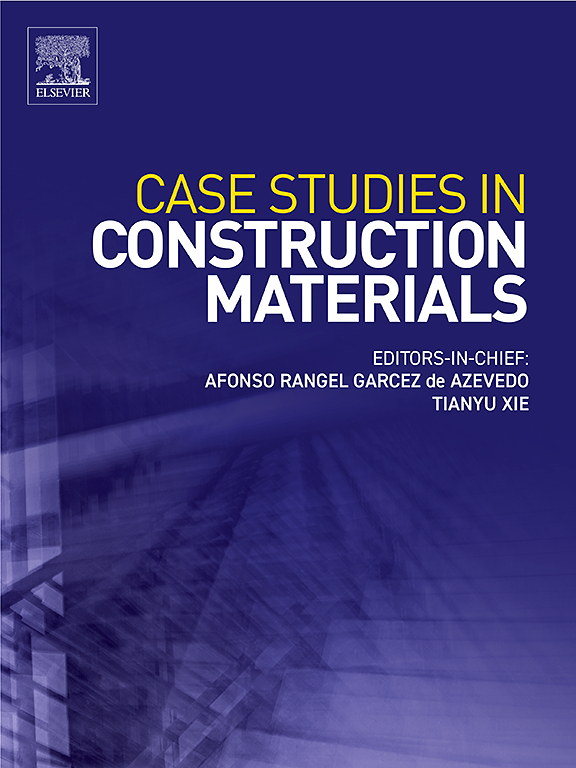钢- pe混杂纤维增强3d打印高强ECC的界面结合和孔隙结构优化
IF 6.6
2区 工程技术
Q1 CONSTRUCTION & BUILDING TECHNOLOGY
引用次数: 0
摘要
工程胶凝复合材料(ECC)是3d打印混凝土(3DPC)的理想候选材料,因为它们具有优异的应变硬化性能;然而,由于叠层过程中产生的层间界面缺陷严重制约了其力学性能的发展。在本研究中,我们提出采用钢纤维/聚乙烯(PE)纤维混杂增强策略,系统研究钢纤维配比(0-0.6 vol%)对3d打印高强ECC (HS-ECC)层间界面劈裂强度和孔隙结构的影响机理。利用x射线计算机断层扫描(X-CT)定量分析了孔隙的三维分布,并利用扫描电子显微镜(SEM)观察了纤维-基体界面过渡区的微观形貌。试验表明:当钢纤维掺量增加到0.6 %时,抗压强度提高约15 %,界面劈裂抗拉强度提高50.12 %,但单轴拉伸应变能力降低18.92 %,表明纤维掺量存在强度-延性权衡效应;X-CT重建结果表明,与浇铸模相比,打印试样的条状孔隙率降低了15.01 %,孔隙率以孔径为<; 100 μm的小孔隙为主,但层间界面微观形成。X-CT和SEM分析证实,钢纤维在打印方向上表现出明显的取向分布,通过桥接效应抑制了界面裂纹的扩展。复合混合钢纤维通过优化纤维取向分布和层间界面微观结构,显著提高了界面劈裂抗拉强度,为解决3DPC层间表面薄弱问题提供了有效途径,对提高3DPC质量具有重要意义。本文章由计算机程序翻译,如有差异,请以英文原文为准。
Enhancing interfacial bonding and pore structure optimization in 3D-printed high-strength ECC with steel-PE hybrid fibers
Engineered cementitious composites (ECC) are ideal candidates for 3D-printed concrete (3DPC) due to their excellent strain-hardening properties; however, the interlayer interfacial defects caused by the layer-by-layer stacking process severely restrict the development of their mechanical properties. In this study, we propose to adopt a steel fiber/polyethylene(PE) fiber hybrid reinforcement strategy to systematically investigate the mechanism of the influence of steel fiber compounding ratio (0–0.6 vol%) on the splitting strength and pore structure of the interlayer interfaces of 3D-printed high-strength ECC (HS-ECC). The three-dimensional distribution of pores was quantitatively resolved by X-ray computed tomography (X-CT), and the micro-morphology of the transition zone at the fiber-matrix interface was observed by scanning electron microscopy (SEM). The test shows that: when the steel fiber doping is increased to 0.6 %, the compressive strength is improved by about 15 %, and the interfacial splitting tensile strength is improved by 50.12 %, but the uniaxial tensile strain capacity decreases by 18.92 %, which reveals that there is a strength-ductility trade-off effect in the proportion of fiber mixing; the X-CT reconstruction reveals that the porosity within the strips of the printed specimen is reduced by 15.01 % compared with that of the poured molding and the porosity is dominated by small pores of a pore size of < 100 μm, but the interlayer interfacial interface microforms. The X-CT and SEM analyses confirmed that the steel fibers showed a significant orientation distribution in the printing direction, which inhibited the interface crack extension through the bridging effect. By optimizing the fiber orientation distribution and the microstructure of the interlayer interface, the compound-mixed steel fibers significantly improved the interfacial splitting tensile strength, which provides an effective way to solve the problem of weak interlayer surfaces in 3DPC, and is of great significance in improving the quality of 3DPC.
求助全文
通过发布文献求助,成功后即可免费获取论文全文。
去求助
来源期刊

Case Studies in Construction Materials
Multiple-
CiteScore
7.60
自引率
19.40%
发文量
842
审稿时长
63 days
期刊介绍:
Case Studies in Construction Materials provides a forum for the rapid publication of short, structured Case Studies on construction materials. In addition, the journal also publishes related Short Communications, Full length research article and Comprehensive review papers (by invitation).
The journal will provide an essential compendium of case studies for practicing engineers, designers, researchers and other practitioners who are interested in all aspects construction materials. The journal will publish new and novel case studies, but will also provide a forum for the publication of high quality descriptions of classic construction material problems and solutions.
 求助内容:
求助内容: 应助结果提醒方式:
应助结果提醒方式:


